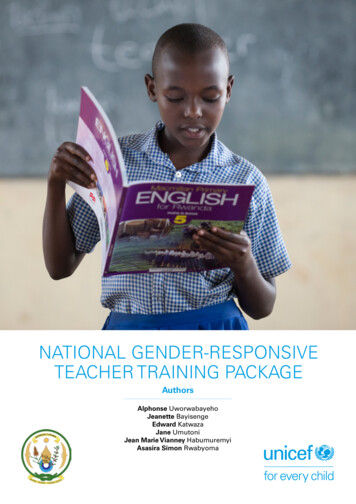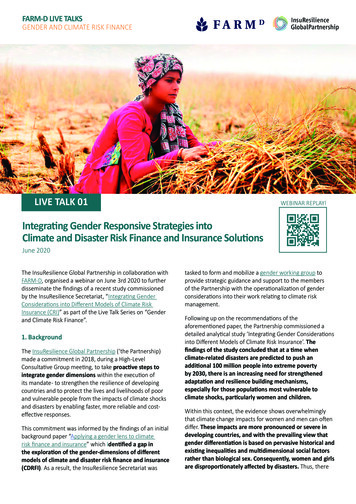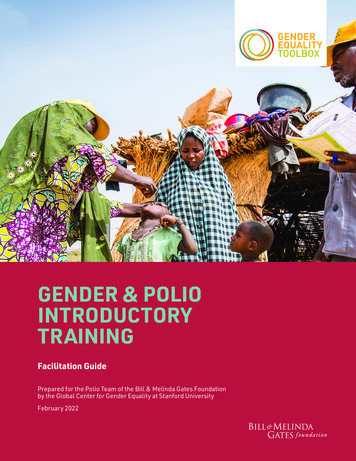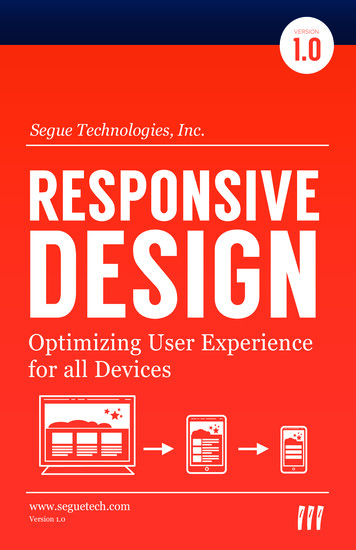
Transcription
UNICEF Rwanda/2015/RandazzoNATIONAL GENDER-RESPONSIVETEACHER TRAINING PACKAGEAuthorsAlphonse UworwabayehoJeanette BayisengeEdward KatwazaJane UmutoniJean Marie Vianney HabumuremyiAsasira Simon RwabyomaNATIONAL GENDER-RESPONSIVE TEACHER TRAINING PACKAGE 1
MINEDUC, 2018Published in 2017 by the Ministry of Education-RwandaUnited Nations Children’s Fund-Rwanda (UNICEF)National Gender-Responsive Teacher Training PackageNATIONAL GENDER-RESPONSIVE TEACHER TRAINING PACKAGE 2
PREFACEThis National Gender Responsive Teacher Training Package is developed to guide bothteachers and school leaders in facilitating teaching in a school environment that is genderresponsive. The package enables teachers and learners to apply techniques and shareactivities that can be used in classroom settings. Teachers play a key role in helping childrenacquire knowledge, skills and attitude necessary for the 21st Century.In line with the implementation of Education for All Goals, Gender-Responsive Pedagogy(GRP) was initiated in 2005 and has been introduced in many African countries (FAWE,2009). In the Rwandan context, the turn towards gender responsive pedagogy is an aspectof the education policy. More so, gender is one of the cross-cutting issues identified in theCompetence-based Curriculum (CBC) for pre/primary and secondary education and it needsto be addressed in the teaching and learning process for appropriate life skills development.This package is, therefore, meant to equip teachers with the means to integrate genderresponsive pedagogy into the learning process, which includes: lesson planning, teaching,managing classroom activities and performance evaluation. It is also incumbent upon theschool leadership to create an enabling school environment that is gender responsive.The package comprises of five sections. Section one is covering the introduction andrationale of the GRP Training Package. Section two is about learning outcomes and conceptsrelated to gender and education. Section three is focussing on gender responsive pedagogy;which includes responsive teaching and learning environment; gendered language use inthe classroom and at school; teaching and learning resources; lesson planning and delivery;gender responsive interactions; and gender responsive assessment. Section four is lookingat gender responsive school leadership which includes; child protection and school safety;gender responsive budgeting and teacher training and professional development. Sectionfive is on monitoring and evaluation on gender responsive pedagogy, with sub sectionson the importance of monitoring and evaluation in gender responsive pedagogy; parentaland community involvement in gender responsive pedagogy; and also a guide to using thechecklist.Professor Nelson Ijumba, PhDDeputy Vice Chancellor Academic Affairs and ResearchUniversity of Rwanda2018 UNICEFRwanda/2017/BellNATIONAL GENDER-RESPONSIVE TEACHERTRAININGPACKAGE III
ACKNOWLEDGEMENTSWe would like to acknowledge the support and participation of the following institutions andorganizations that contributed to the development of this National Gender-ResponsiveTeacherTrainingPackage: the Ministry of Education Rwanda, which commissioned the development of this teachertraining package; UNICEF Rwanda, which funded it; and the University of Rwanda, Centre for GenderStudies, which developed it.We also acknowledge the technical contributions made by various stakeholders who were instrumentalin providing insights and critical inputs for making this training package relevant for use. Profoundgratitude goes to the primary and secondary schools and Teacher Training Colleges in Rwandafor providing the relevant primary and secondary data that were used in developing this GenderResponsive Teacher Training Package and Teacher Guide.NATIONAL GENDER-RESPONSIVE TEACHER TRAINING PACKAGE IV
ACRONYMS ANDABBREVIATIONSCBCCompetence-Based CurriculumEFAEducation for AllEICVIntegrated Household Living Conditions SurveyESSPEducation Sector Strategic PlanFAWEForum for African Women EducationalistsGRPGender-Responsive PedagogyMINEDUCMinistry of EducationP1, P2Primary 1, Primary 2REBRwanda Education BoardSDGsSustainable Development GoalsSGACSchool General Assembly CommitteeTTCTeacher Training CollegeUNUnited NationsUNESCOUnited Nations Educational, Scientific and Cultural OrganizationUNICEFUnited Nations Children’s FundNATIONAL GENDER-RESPONSIVE TEACHER TRAINING PACKAGE V
ContentsPreface. iiiAcknowledgements. ivAcronyms and Abbreviations. vSection 1: Introduction to the GRP Training Package. 1Background of the GRP package. 3Rationale of the GRP package. 3How to use this Guide?. 4Section 2: Key concepts related to gender and education. 6Learning outcomes. 8Definition of selected gender and education concepts. 9Section 3: Gender-responsive pedagogy.14Gender-responsive teaching and learning environment. 16Gendered language use in the classroom and at school. 18Teaching and learning resources. 21Lesson planning and delivery. 22Gender-responsive interactions. 22Gender-responsive assessment. 25Section 4: Gender-responsive school leadership. 26Child protection and school safety. 28Gender-responsive budgeting. 29Teacher training/teacher professional development. 32Section 5: Monitoring and evaluation on gender-responsive pedagogy. 33Importance of monitoring and evaluation in GRP. 34Parental and community involvement in GRP monitoring and evaluation. 35Classroom observation and supervision on GRP. 35Gender audit in schools. 36References. 37Appendices. 39Appendix 1: Making a lesson gender-responsive. 40Appendix 2: Monitoring and evaluation checklist for a GRP school. 42Appendix 3: Ten activities (as indicative) for effective GRP implementation. 44NATIONAL GENDER-RESPONSIVE TEACHER TRAINING PACKAGE VI
UNICEF Rwanda/2017/BellSECTION 1: INTRODUCTION TOTHE GRP TRAINING PACKAGENATIONAL GENDER-RESPONSIVE TEACHER TRAINING PACKAGE 1
Background of the GRP packageRwanda’s education system currently boaststhe highest participation rates in East Africa andgender parity in net and gross enrolment at preprimary, primary and secondary levels. In fact,girls’ enrolment surpasses boys’ enrolmentat primary and secondary levels (MINEDUC,2016). Despite these achievements, gendercontinues to play an important but complex rolein the enabling environment for girls’ and boys’learning. National data show that both girls andboys face gender-related barriers to learning.However, based on national examination results,on average, boys outperformed girls in almostall districts at P6 and S3 levels during the period2008–2014 (MINEDUC, 2015). This is an indicationthat girls may face more challenges than boys.An analysis of data shows the percentage ofchildren making it from P1 to P6 in the previoussix years was only 10 per cent on average; forboys, the percentage was slightly lower thanfor girls (EICV, 2014). This shows that, whilegirls’ face many challenges related to learning,progression and completion, boys face their ownchallenges that include repeating and droppingout of primary school (Ibid.).There are a number of gender-related barriersthat may lead to the above scenario, and theseinclude: Social norms – where traditional powerstructures dictate that girls and womenhave less power than boys and men, andchildren have less power than parents; Low capacity of schools to providelearning support services for girls andboys falling behind academically; Teachers who are not equipped with theawareness, knowledge and skills requiredto teach in a gender-responsive manner,and who may not even be aware of theirown gender bias; Lack of understanding of the genderbarriers facing boys’ retention in school,since most of the work on gender andeducation focuses on girls; and Inadequate engagement with boys andmen to promote positive masculinities inand out of school.From the observations above, it is clear thatthe Education for All (EFA) goals number twoand five have not been achieved as planned.Goal two clearly highlights that by 2015, allchildren, particularly girls, children in difficultcircumstances and those belonging to ethnicminorities, have access to and complete freeand compulsory primary education of goodquality. Goal five emphasizes eliminating genderdisparities in primary and secondary educationby 2015, and achieving gender equality ineducation by 2015, with a focus on ensuring girls’full and equal access to and achievement in basiceducation of good quality (UNESCO, 2000).It is therefore important to focus on achievingthe Sustainable Development Goal (SDG) 4,which aims to ‘ensure inclusive and equitablequality education and promote lifelong learningopportunities for all’. The Global Education 2030agenda provides guidance for the implementationof this goal and commitment. One of the targetsto achieve SDG 4 states that ‘By 2030, ensure thatall girls and boys complete free, equitable andquality primary and secondary education leadingto relevant and effective learning outcomes’(Osborn, Cutter and Ullah, 2015).The Government of Rwanda has developedrelevant policies and strategies that respond toexisting challenges for girls and boys in primaryand secondary education. These include: Girls’ Education Policy; National Gender Policy; Curriculum and Assessment Policy; Education Sector Strategic Plan (ESSP);and Vision 2020.NATIONAL GENDER-RESPONSIVE TEACHER TRAINING PACKAGE 2
all the causes and obstacles which can leadto disparity in education by gender, disability,geographical or social group’.The new Rwanda Curriculum and AssessmentPolicy (2014) also includes gender as one of itscross-cutting areas. In the competence-basedcurriculum (CBC), gender is taught in schoolsbeginning with family complementarities,gender roles and responsibilities, the need forgender equality and equity, gender stereotypes,gender sensitivity, gender mainstreaming andgender-blindness. Gender is one of the crosscutting issues in Rwanda’s Competence BasedCurriculum (2015). The implementation ofthe CBC is therefore supposed to be genderresponsive. Since teachers are among the keyfacilitators of the learning process that addressesgender issues from primary level to secondarylevel of education, this GRP training package willempower them to integrate gender-responsivepedagogy.Rationale of the GRP package UNICEF Rwanda/2017/BellThe Girls’ Education Policy (2008) aims to guideand promote sustainable action towards theelimination of gender disparities in educationand in management structures. The ESSPidentifies the education of girls and womenas one of its ‘central strategies’ to ensure thatthere is an inclusive basic education for all,and beyond basic schooling to ensure thatwomen are appropriately skilled to contributepositively to economic and social development.Undoubtedly, equality between women andmen is a fundamental condition of sustainabledevelopment. The ESSP also aims ‘to eliminateThe rationale to develop a gender-responsivetraining package is to improve the genderresponsiveness of teaching methodologies andschool environments. The training materials willbetter equip teachers and education leadersto teach in a way that responds to the needs ofgirls and boys; equip teachers with the resourcesrequired to respond to gender-based incidencesin the classroom; and raise awareness aboutgender issues in education. The training packagewill also help pre-service teacher trainingprogrammes to be more gender-sensitive.Drawing on the Competence-Based Framework(REB, 2015; p.22): ‘The introduction of a genderperspective to the curriculum aims to improvethe outcome of quality teaching by enablinggirls and boys to exploit their full potential andtalents without any discrimination or prejudice.Curriculum development to address genderinequality cannot happen in isolation from otherNATIONAL GENDER-RESPONSIVE TEACHER TRAINING PACKAGE 3
other aspects of schooling, such as ways of teaching and learning, and interactions within and out ofthe classroom’.Inclusive, gender-responsive learning environments need well-trained teachers who are aware of howtheir own attitudes and preconceptions about gender can affect their teaching; who take steps toprevent gender bias and gender-based discrimination in their teaching and in their classrooms; andwho are supported in using different approaches and strategies to engage all children positively andeffectively in lessons.This training package therefore aims at supporting primarily teachers in a creating classroomenvironment that is gender-responsive. However, the package is also useful for other educationstakeholders whose main role includes monitoring and evaluating teaching and learning process.How to use this guide?The GRP Training Package is intended for use by primary and secondary school teachers, technical andvocational schools, school leaders and other officials. The package will mainly be used as a referencedocument for teachers in preparation of competence-based lesson plans and delivery of lessons. Whatmakes this package exciting as a resource is in how it can be used to help all education stakeholdersmeet competence-based curriculum requirements in terms of gender-responsive pedagogy. It isdesigned to provide users with a clear understanding of key concepts related to gender and gender-NATIONAL GENDER-RESPONSIVE TEACHER TRAINING PACKAGE 4
UNICEF Rwanda/2017/Bellresponsive pedagogy, as well as monitoring and evaluation.The package is designed to support the implementation syllabus (curriculum) developed by the RwandaEducation Board for each subject. Users will go through Sections 1 and 2 to familiarize themselveswith the concept of gender-responsive pedagogy; and then section 3 focuses on teaching techniquesand learning activities to achieve a specific instructional objective in terms of gender-responsivepedagogy. Sections 4 and 5 provide guiding tools in creating a school environment and monitoringclassroom that are gender-responsive. Reflective activities starting each section allow participantsto reflect on their own schools, classroom practices, and/or national policies with regard to genderresponsive pedagogy. During the training, the trainer may use reflective activities to enhance theactive participation of trainees.NATIONAL GENDER-RESPONSIVE TEACHER TRAINING PACKAGE 5
UNICEF Rwanda/2015/RandazzoSECTION 2: KEY CONCEPTSRELATED TO GENDER ANDEDUCATIONNATIONAL GENDER-RESPONSIVE TEACHER TRAINING PACKAGE 6
Women and girls represent more than half of the world’s population, yet gender inequality is oftenwitnessed and persists all over the world. It is fair to say it hinders development in general. Regardlessof where you live, gender equality is a fundamental human right. Advancing gender equality is criticalto all areas of national development policies such as health, labour, education as well as the wellbeing of women and men (UN, 2016)The international discourse emphasizes equal access to quality education for all children as animportant part of achieving sustainable development for most countries. As many countries are tryingto meet the goals of access to education, the international debate is now focusing on the equity forboys and girls and improving education (Michelle, 2015). This section will enable users to have asound understanding of gender and education-related concepts.Learning outcomes To have a sound understanding of gender concepts; To explore the relationship between gender and education; and To be able to reflect on how to apply gender concepts to learning processes.Reflective activitiesActivity 1Use matching game: Create group of 2/3 match game on gender concepts: Instructions: For each term,find the matching definition. It is best to complete this exercise in groups of two or three – whetherface to face or individually. UNICEF Rwanda/2015/RandazzoNATIONAL GENDER-RESPONSIVE TEACHER TRAINING PACKAGE 7
TermsDefinitions1. GenderAPreference given to some people based on their sex2. Gender analysisBConsidering and responding to the different needs of men/boys and women/girls3. Gender awarenessCLooks at how access to and control over resources are different between girls/women and boys/men4.Gender discrimination DCharacteristics, attitudes or behaviours that are expected of girls/women orboys/men5. Gender equityEPositive or negative generalizations about the roles, attributes and behavioursof girls/women or boys/men6. Gender responsiveFUnwanted conduct of a sexual nature7. Gender stereotypeGWork in and around the household that usually does not generate monetaryincome8.PracticalneedsHBoys/men and girls/women having equal access to educationIAny work that generates goods or services to meet economic or subsistenceneeds10. Reproductive workJKnowing there are socially and culturally determined differences betweenwomen and men11. Sexual harassmentKBasic survival needs, such as food, water and shelter12. StrategicinterestsLRoot causes of social, economic and political inequality between gendersgender9. Productive workgenderActivity 2: Construction of genderWrite ‘S’ for biological and ‘G’ for gender for statements you consider appropriate.1.Women give birth to babies; men do not.2. Girls are gentle; boys are rough.3. Doctors are men; nurses are women.4. Boys don’t cry.5. Boys are good at math and science and girls are good at language and history.6. When one thinks of an engineer, one hardly ever thinks of a woman.7.Women work two thirds of the world’s working hours, produce half of the world’s food and yet earn only 10%of the world’s income and own less than 1% of the world’s property.8. Boys’ voices break at puberty; girls’ do not.9. A girl is expected to return home early while a boy can comfortably have a night out with his friends.10. Kindergarten teachers should be women; men are not good at taking care of young children.NATIONAL GENDER-RESPONSIVE TEACHER TRAINING PACKAGE 8
Activity: 3The purpose of this activity is to identify someexamples of how social, cultural, economicand political contexts can affect boys and girlsdifferently in an education setting. What do you understand by ‘sociallyconstructed’? What socially constructed variables areimportant to consider in your school? Should biological differences matterwhile defining social roles andresponsibilities? If girls fair (perform) better than boysin academics, why do we have poorerliteracy rates for girls and women? Why should boys be given so-called‘masculine’ tasks and girls ‘femininetasks’? If the women around the world constituteapproximately half of the population andtheir participation in all spheres includingworkforce is more than that, why dothey own less than one tenth of the totalwealth? Give examples of how social, cultural,economic and political contexts can affectboys and girls differently.Definition of selected gender and educationconceptsTo equip the reader with some gender basicsin the context of gender-responsive teachertraining, below is a glossary of selected genderand education-related concepts and terms. Thedefinitions for this document were borrowedfrom different sources that include Frei andLeowinata (2014), Pilcher and Whelehan (2004),University of Rwanda Gender Policy (2016) andChristodoulou (2005).socially constructed roles, behaviours, activitiesand attributes that a given society considersappropriate for men and women. Sex refers tothe biological and physiological characteristicsthat define men and women. It is defined as theanatomical and physiological characteristics thatsignify the biological maleness and femalenessof an individual.Gender sensitivity means the ability to recognizeand/or the recognition of gender equity andequality issues.Gender equity is the process of being fair towomen and men. To ensure fairness, measuresmust be taken to compensate for historical andsocial disadvantages that prevent women andmen from operating on a level playing field.Gender equality refers to the elimination of allforms of discrimination so that all girls and boysand /or women and men have equal opportunitiesand benefits. In terms of education, it is beyondthe equal participation of boys and girls – i.e., italso includes performances as well as creatinggender-responsive institutional arrangement.Gender responsive refers to planning and carryingout programmes, policies or activities in waysthat consider the different needs of men/boysand women/girls and involve them in decisionmaking, participation and opportunities. Thisusually requires developing specific actions tobring about more equitable gender relationships,and it may require clearly targeted budgetallocations.Gender awareness refers to an understandingthat there are socially and culturally determineddifferences between women/girls and men/boysbased on learned behaviours which affect theirability to access and control resources.Selected gender conceptsGender blindness is the failure to recognize andaddress the different needs and interests of malesand females.Gender versus sex: Gender refers to theGendered language is commonly understood asa language that has a bias towards a particularNATIONAL GENDER-RESPONSIVE TEACHER TRAINING PACKAGE 9
sex or social gender. In English, this wouldinclude using gender-specific terms referring toprofessions or people, or using the masculinepronouns (he, him and his) to refer to people ingeneral.Gender mainstreaming is the process ofincorporating a gender perspective into policies,strategies, programmes, project activities andadministrative functions, as well as into theinstitutional culture of an organization.Gender analysis is a methodology that both: Describes existing gender relationsin a particular environment, rangingfrom within households or firms toa larger scale of community, ethnicgroup or nation. It involves collectingand analysing sex-disaggregated dataand other qualitative and quantitativeinformation. Organizes and interprets, in a systematicway, information about gender relationsto make clear the importance of genderdifferences for achieving developmentobjectives.Sex-disaggregated data refer to information thatis collected separately on men and women orboys and girls. These data can be used to look athow girls and women are faring compared withboys and men, rather than only using data thatlump them together.Gender assessment examines how a programmeor project addresses and responds to genderdisparities and inequalities through its objectives,activities and policies.Gender needs are an acknowledgement that girls/women and boys/men often have different needs.These include basic needs or survival needs thatrelate to inadequacies in living and workingconditions, such as toilet facilities, food, water,housing, clothing and health care. These needscan be classified as either strategic or tunities and rights to individuals on thebasis of their sex.Gender bias refers to unequal treatment ofpersons in relation to opportunities, expectationsand more based on their sex.Gender based violence is violence derived fromgender norms and roles as well as from unequalpower relations between women and men.Violence is specifically targeted against a personbecause of his or her gender, and it affectswomen disproportionately. It includes, but is notlimited to, physical, sexual and psychologicalharm (including intimidation, suffering, coercionand/or deprivation of liberty within the family orwithin the general community).Sexual harassment is the unwanted conduct ofa sexual nature affecting the safety or dignityof women, men, boys or girls, including theconduct of superiors and peers. In addition to aforced sexual act, sexual harassment includesabusive language and gestures, sexual advances,touching and groping, passing unwanted notes,and character assassination through graffiti orgossip.Gender roles are defined as the social rolesthat a person is expected to fulfill based onhis or her gender. These vary among differentsocieties and cultures, classes, ages and duringdifferent periods in history. Gender specific rolesand responsibilities are often conditioned byhousehold structure, access to resources, specificimpacts of the global economy, and other locallyrelevant factors such as ecological conditions.Social construction is a process through whicha given community assigns, institutionalizes andlegitimizes gender roles and relations.Gender empowerment refers to the expansion ofpeople’s capacity to make and act upon decisions(agency) and to transform those decisions intodesired outcomes, affecting all aspects of theirlives. It entails overcoming socio-economic andother gender inequalities in a context where thisability was previously denied.NATIONAL GENDER-RESPONSIVE TEACHER TRAINING PACKAGE 10
Gender-transformative is where both men andwomen are helped as more gender-equitablerelationships are promoted. A transformativeapproach identifies ways of engaging menand women to examine, question and changeinstitutions and norms that perpetuateinequalities.Patriarchy literally means rule by the male headof a social unit (for example, a family or tribe).Thepatriarch, typically a societal elder, has legitimatepower over others in the social unit, includingother (especially younger) men, all women andchildren.Gender stereotypes are ideas that people haveon masculinity and femininity: what men andwomen of all generations should be like and arecapable of doing (e.g., girls should be obedient,are allowed to cry, and boys are expected to bebrave and not cry, women are better housekeepersand men are better with machines, or boys arebetter at mathematics and girls are more suitedto nursing).Femininity refers to a set of attributes, behavioursand roles generally associated with girls andwomen. Stereotypical characteristics: emotional,dependent, sensitive, passive and nurturing.Masculinity refers to possessing qualities orcharacteristics considered typical of or appropriateto a man. Stereotypical characteristics: strong,unemotional, competitive, aggressive and selfconfident. Masculinity can be practiced by eithermen or women.Men/boys engagement refers to a programmaticapproach that involves men and boys as clientsand beneficiaries, partners and agents of changein actively promoting gender equality andwomen’s empowerment.Gender construction is socialization processesthat start from birth through which gender isconstructed.Gender socialization is the process by whichsociety’s roles, values and norms, including thosepertaining to gender, are taught and learned.It is a lifelong changing process and often anunconscious process where expectations arereinforced with rewards and punishments (forexample, boys or girls may receive negativesanctions for not following ‘gender-appropriatebehaviour’).Selected education conceptsEducation refers to the process of facilitatinglearning, or the acquisition of knowledge, skills,values, beliefs and habits. Education frequentlytakes place under the guidance of educators, butlearners may also educate themselves. Educationcan take place in formal or informal settings andany experience that has a formative effect on theway one thinks, feels or acts may be considerededucational.Pedagogy generally refers to the art andprofession of teaching. It stands for how ateacher delivers a lesson, the methodology oneuses as a teacher, and the style of teaching ateacher chooses. Educational methods includestorytelling, discussion, lecturing, training, anddirected research.Curriculum is the set of courses and their contentsoffered by an institution such as a school oruniversity. In some cases, a curriculum may bepartially or entirely determined by an externalbody (such as the Rwanda Education Board inRwandan schools).H
responsive pedagogy into the learning process, which includes: lesson planning, teaching, managing classroom activities and performance evaluation. It is also incumbent upon the school leadership to create an enabling school environment that is gender responsive. The package comprises of five sections. Section one is covering the introduction and










